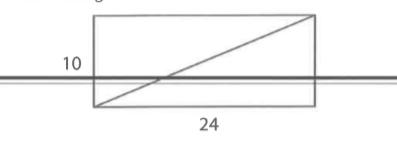The extremities of a diagonal of a rectangle are (0.0) and (4, 4). The locus of the extremities of the other diagonal is equal to
The correct Answer is:A
To find the locus of the extremities of the other diagonal of the rectangle given the extremities of one diagonal at points (0, 0) and (4, 4), we can follow these steps:
Step 1: Understand the Geometry of the Rectangle
The rectangle has vertices A(0, 0) and C(4, 4). Let the other two vertices be B(h, k) and D(4 + h, k) such that the diagonals AC and BD intersect at the midpoint of both diagonals.
Step 2: Find the Midpoint of Diagonal AC
The midpoint M of diagonal AC can be calculated as:
M=(0+42,0+42)=(2,2)
Step 3: Use the Property of Perpendicularity
Since AB is perpendicular to BC, we can use the slopes to find a relationship between h and k. The slope of AB is:
slope of AB=k−0h−0=kh
The slope of BC is:
slope of BC=k−4h−4
Since AB is perpendicular to BC, we have:
kh⋅k−4h−4=−1
Step 4: Cross-Multiply and Rearrange
Cross-multiplying gives:
k(k−4)=−h(h−4)
Expanding both sides:
k2−4k=−h2+4h
Rearranging gives:
k2+h2−4h−4k=0
Step 5: Express in Terms of x and y
Let x=h and y=k. Then we can rewrite the equation as:
x2+y2−4x−4y=0
Step 6: Identify the Locus
The equation x2+y2−4x−4y=0 represents the locus of the extremities of the other diagonal of the rectangle.
Conclusion
The locus of the extremities of the other diagonal is given by:
x2+y2−4x−4y=0
Final Answer
The correct option is:
Option 1: x2+y2−4x−4y=0
---
The rectangle has vertices A(0, 0) and C(4, 4). Let the other two vertices be B(h, k) and D(4 + h, k) such that the diagonals AC and BD intersect at the midpoint of both diagonals.
The midpoint M of diagonal AC can be calculated as:
M=(0+42,0+42)=(2,2)
Since AB is perpendicular to BC, we can use the slopes to find a relationship between h and k. The slope of AB is:
slope of AB=k−0h−0=kh
The slope of BC is:
slope of BC=k−4h−4
Since AB is perpendicular to BC, we have:
kh⋅k−4h−4=−1
Cross-multiplying gives:
k(k−4)=−h(h−4)
Expanding both sides:
k2−4k=−h2+4h
Rearranging gives:
k2+h2−4h−4k=0
Let x=h and y=k. Then we can rewrite the equation as:
x2+y2−4x−4y=0
The equation x2+y2−4x−4y=0 represents the locus of the extremities of the other diagonal of the rectangle.
The locus of the extremities of the other diagonal is given by:
x2+y2−4x−4y=0
The correct option is:
Option 1: x2+y2−4x−4y=0
Topper's Solved these Questions
- COORDINATE SYSTEMBOOK - CENGAGE ENGLISHCHAPTER - COORDINATE SYSTEMEXERCISE - Comprehension Type
4 Videos
- COORDINATE SYSTEMBOOK - CENGAGE ENGLISHCHAPTER - COORDINATE SYSTEMEXERCISE - Multiple Correct Answers Type
2 Videos
- CONTINUITY AND DIFFERENTIABILITYBOOK - CENGAGE ENGLISHCHAPTER - CONTINUITY AND DIFFERENTIABILITYEXERCISE - Comprehension Type
2 Videos
- COORDINATE SYSYEM BOOK - CENGAGE ENGLISHCHAPTER - COORDINATE SYSYEM EXERCISE - JEE Main
6 Videos
Similar Questions
The extremities of a diagonal of a rectangle are (0,0) and (4,3). The equation of tangents to the circumcircle of the rectangle which are parallel to the diagonal are
View SolutionExtremities of a diagonal of a rectangle are (0, 0) and (4, 3). The equations of the tangents to the circumcircle of the rectangle which are parallel to the diagonal, are
View SolutionThe extremities of a diagonal of a rectangle are (−4,4)and(6,−1). A circle circumscribes the rectangle and cuts an intercept AB on the y-axis. If Δ be the area of the triangle formed by AB and the tangents to the circle at AandB, then 8Δ=.
View SolutionThe diagonals of a rectangle are of equal length.
View SolutionThe vertices of a diagonal of a square are (−2,4) and (−2,−2) Find the other vertices
View SolutionThe extremities of the diagonal of a rectangle are (−4,4) and (6,−1). A circle circumscribes the rectangle and cuts inercept of length AB on the y-axis. The length of AB is
View SolutionIf the extremities of the diagonal of a square are
(1, -2, 3) and (3, -4, 3), the the length of the side is
View SolutionThe co-ordinates of the extremities of one diagonal of a square are (1,1) and (−1,−1) Find the co-ordinates of its other vertices and the equation of the other diagonal
View SolutionThe co-ordinates of the extremities of one diagonal of a square are (1,1) and (1,−1) Find the co-ordinates of its other vertices and the equation of the other diagonal
View SolutionWhat is the diagonal of the rectangle shown?

View Solution
